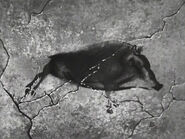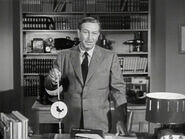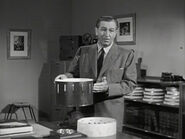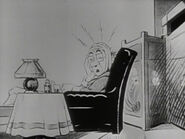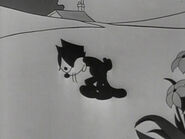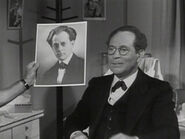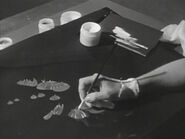"The Story of the Animated Drawing" is an episode of the Disneyland television program.
Synopsis[]
Walt Disney opens the show with a lecture on how the art of animation has taken its rightful place as "the last of the fine arts." He then consults his staff's book project The Art of Animation and shows to the viewer that bringing still pictures to life actually dates back to prehistoric times, proving his point by showing several cave paintings depicting creative ways how a caveman would tell about actions with an inanimate picture. He then goes into ancient Egypt and depicts of how an old mural looked very similar to animation depicted on film strips. We then flash-forward to artist and inventor Leonardo da Vinci and Walt tells of how his famous picture detailing the proportions of the human figure has animation-like qualities to it. Walt then showcases several toys that played on "persistence of vision" and were forerunners of making pictures move, after which he tells of how animation was exhibited to a wide audience for the first time with the French "Théâtre Optique" in the 1890s, even before movie cameras and projectors were invented.
With the coming of motion pictures at the dawn of the 20th century, motion picture film had come in, to which Walt says opened the doors to further animation experiments. He then shows an excerpt of the early animation experiment Humorous Phases of Funny Faces (1903), followed by telling how newspaper cartoonist Winsor McCay revolutionized the animation industry with his film Gertie the Dinosaur (1914), showing a reenactment of the film's original vaudeville performance. Walt goes on about how the animation industry flourished with such creative minds as J.R. Bray, Raoul Barré, Earl Hurd, Pat Sullivan, Otto Messmer, and Max Fleischer (showing his Out of the Inkwell film The Tantalizing Fly accompanied by Disney composer Oliver Wallace playing the organ).
Walt then goes on about how sound added new dimension to animated shorts with the first sound cartoon Steamboat Willie, Mickey Mouse's screen debut, which was soon followed by showing how the Disney studio made music control the animated action with the first Silly Symphony film, The Skeleton Dance. Walt goes on and tells of how animated shorts captivated audience interest so much, that by the mid-1930s, feature-length cartoons could be possible and were proven to be so with early animated features, like Snow White and the Seven Dwarfs and Pinocchio. We then go behind the scenes on the techniques that went into the making of the Nutcracker Suite sequence from Fantasia, followed by closing the show with a complete performance of the sequence.
Gallery[]
Releases[]
The episode was included on the Walt Disney Treasures 2002 DVD collection Behind the Scenes at the Walt Disney Studios. The Gertie the Dinosaur segment can also be found on the Collector's Edition DVD of Dinosaur as an easter egg in the Development section of the second disc. As of June 12, 2020, the episode is also available for streaming on Disney+.




